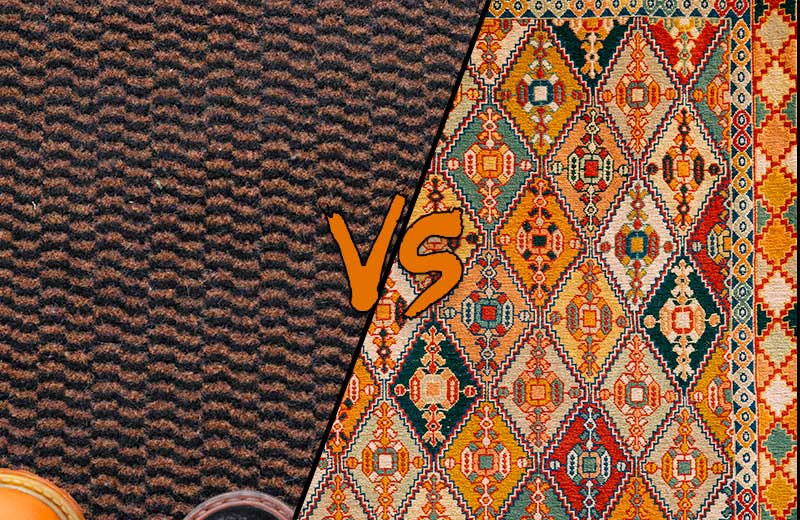When you walk into any home, you’ll often find a mat or carpet, both playing a role in decor and functionality. Knowing their differences can guide you in choosing the right one for each room. Let’s explore what makes mats and carpets unique, the pros and cons of each, and some tips for choosing the right option.
What is a Mat?
A mat is a smaller, versatile floor covering with a practical purpose. Commonly placed at entrances, kitchens, or bathrooms, mats are designed to trap dirt, absorb moisture, or offer a non-slip surface.
Common Uses for Mats
- Entryways: Mats keep dirt, mud, and moisture from being tracked into a home, especially coir or rubber varieties.
- Kitchens: Anti-fatigue mats provide extra comfort while standing, typically made of thick rubber.
- Bathrooms: Bath mats absorb water and help prevent slips, commonly crafted from cotton or microfiber.
Material and Design of Mats
Mats are often made from durable materials like rubber, coir, or cotton. Rubber mats provide a non-slip surface, ideal for high-traffic areas. Coir mats (made from coconut fibers) trap dirt and can withstand outdoor elements, while cotton mats are soft and highly absorbent, suited for bathroom or kitchen use.
Tip: For outdoor areas, choose weather-resistant mats, like coir or rubber, which can withstand varying temperatures and moisture.
What is a Carpet?
Carpets are large, often room-covering textiles that add comfort, warmth, and style, ideal for rooms where you relax or socialize.
Common Uses for Carpets
- Living Rooms: Carpets add comfort, reduce noise, and bring warmth to a room, often in plush materials.
- Bedrooms: The softness of a carpet enhances coziness and insulation, making it ideal for this private space.
- Hallways and Staircases: Carpeted surfaces in these areas reduce noise and create a unified design look.
Material and Design of Carpets
Carpets come in materials like wool, nylon, and polyester. Wool carpets are soft, durable, and naturally stain-resistant but cost more. Nylon is durable and resists stains, making it suitable for high-traffic areas. Polyester provides bright colors at a lower cost but may not last as long as nylon.
Eco-conscious choice: Look for carpets certified by the Carpet and Rug Institute (CRI) for low VOCs, ensuring better indoor air quality.
Key Differences Between Mats and Carpets
| Feature | Mats | Carpets |
| Size and Placement | Small, portable, used in entryways, kitchens, bathrooms | Covers larger areas, common in living rooms, bedrooms |
| Purpose and Function | Dirt-trapping, slip-resistance, fatigue-relief | Warmth, comfort, noise reduction, decor enhancement |
| Material | Rubber, coir, cotton, microfiber | Wool, nylon, polyester |
| Maintenance | Easy to shake or rinse, machine-washable options are available | Requires vacuuming, professional cleaning is often recommended |
| Cost | Budget-friendly and low-maintenance | Higher initial cost, more upkeep |
Tips for Choosing the Right Option
- Consider Room Function: Entryways and high-traffic areas benefit from mats while living spaces are better suited to carpets.
- Evaluate Maintenance Needs: Carpets can require professional cleaning, while most mats are washable or easy to replace.
- Look at Material: Rubber and coir are good for outdoor mats, while wool and nylon are excellent carpet materials for comfort and durability.
- Think of Long-Term Costs: Carpets may have a higher initial cost and maintenance but can add resale value to a home, while mats are more affordable and easy to swap out.
Conclusion
Choosing between a mat and a carpet depends on your space, function, and maintenance preferences. Mats suit high-traffic or functional areas, while carpets bring warmth and comfort to larger rooms. With the right choice, mats and carpets can complement each other, enhancing both style and practicality in any home.
For more tips on maintaining mats and carpets, refer to the Carpet and Rug Institute’s resources on cleaning and care.
FAQs
Mats, especially rubber or coir types, can withstand pet activity and are easy to clean. Carpets can trap pet hair but add comfort; choose low-pile, stain-resistant options.
Mats are easier to clean regularly, while carpets may trap allergens. Opt for low-pile, washable carpets and vacuum with a HEPA filter for better air quality.
Mats, especially rubber or coir, generally handle wear and tear better in high-traffic areas, while carpets may wear down faster but add comfort and warmth.
Yes, many mats are made from sustainable materials like coir and recycled rubber, while carpets made of natural fibers like wool or those with low VOCs are eco-friendly options.





